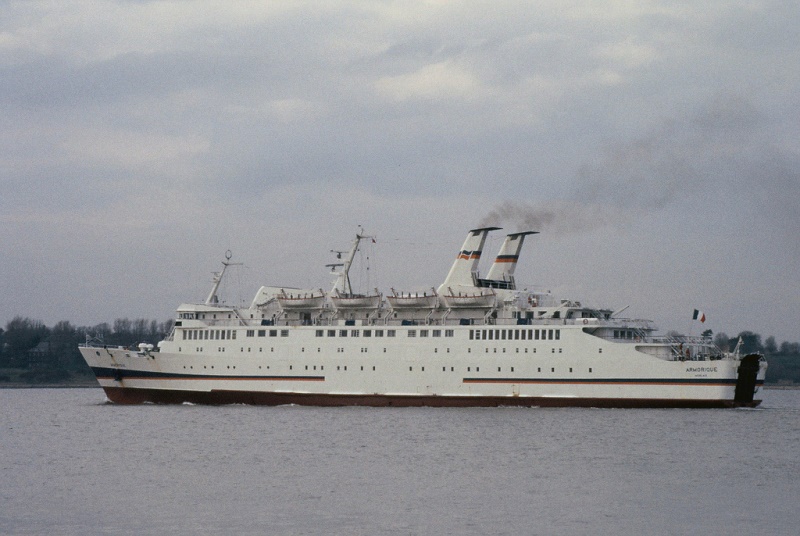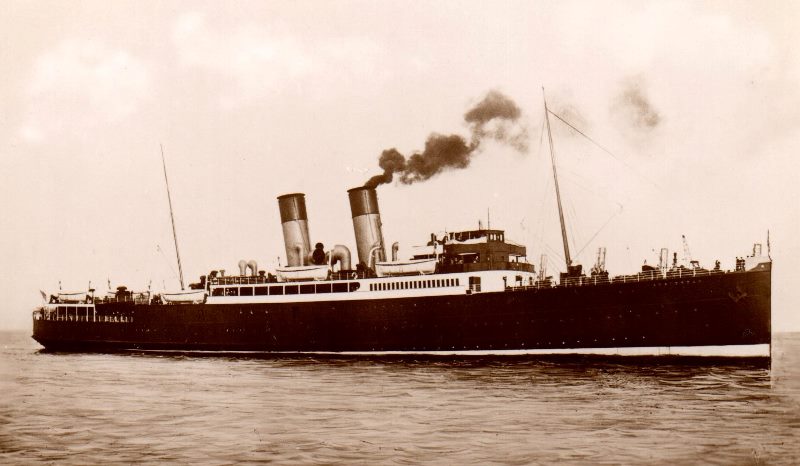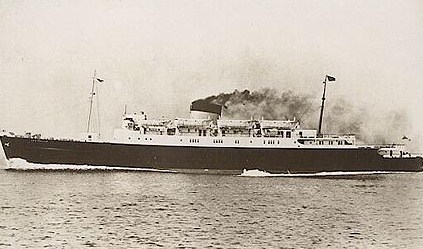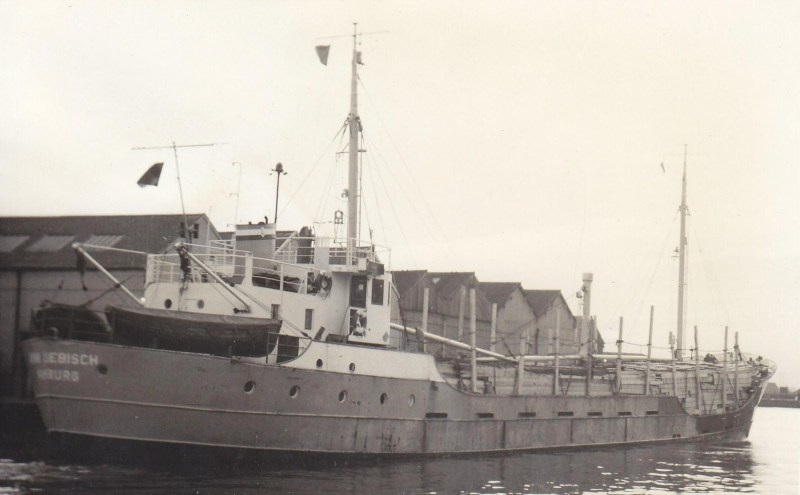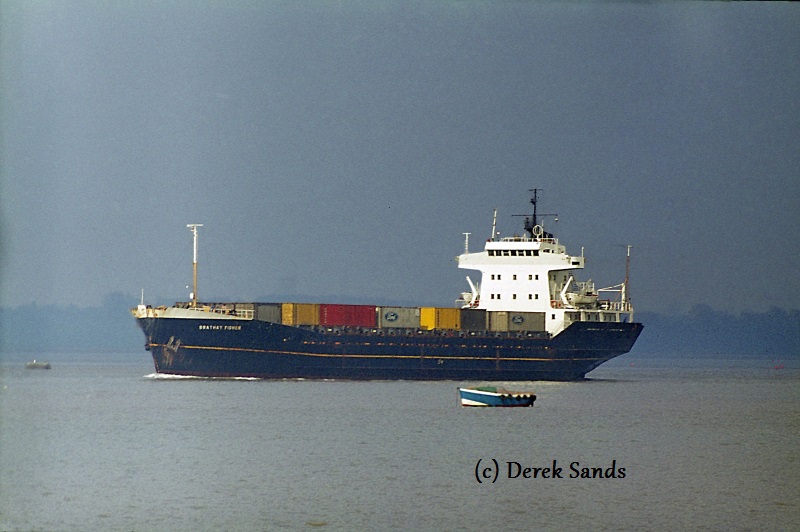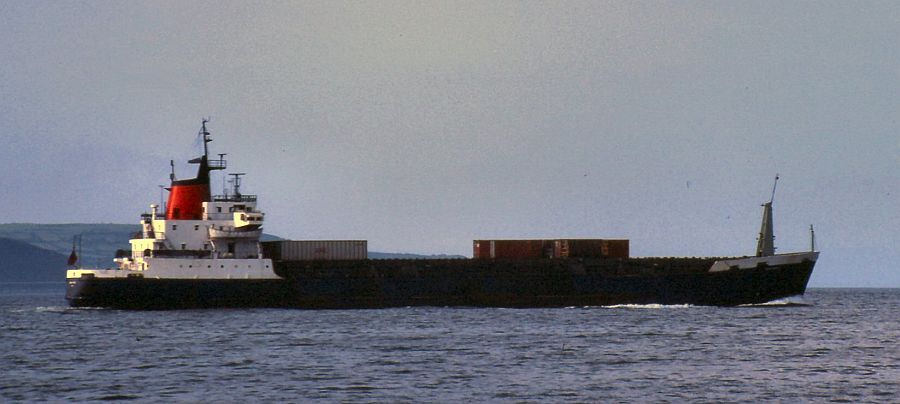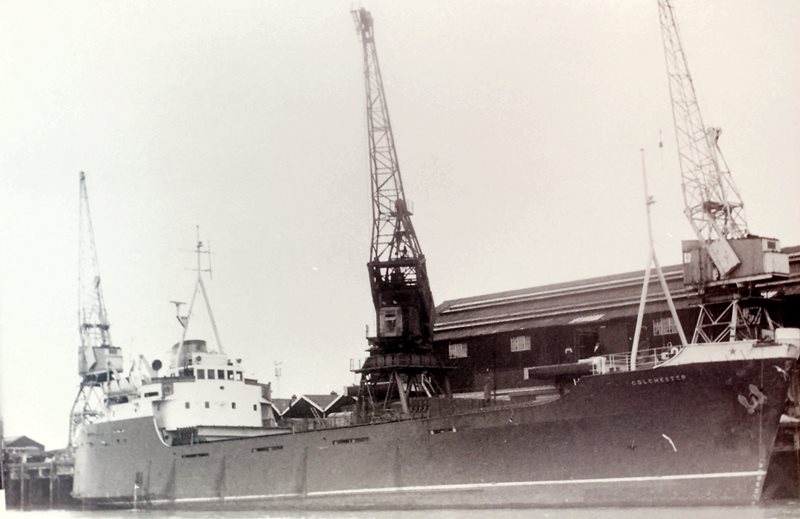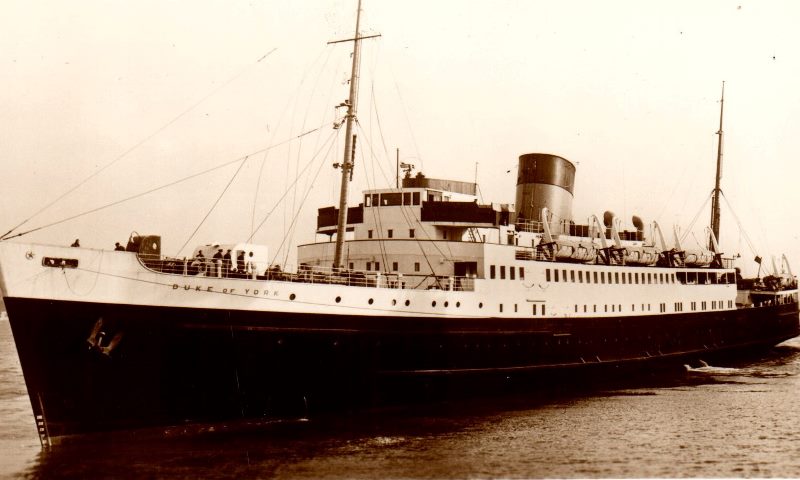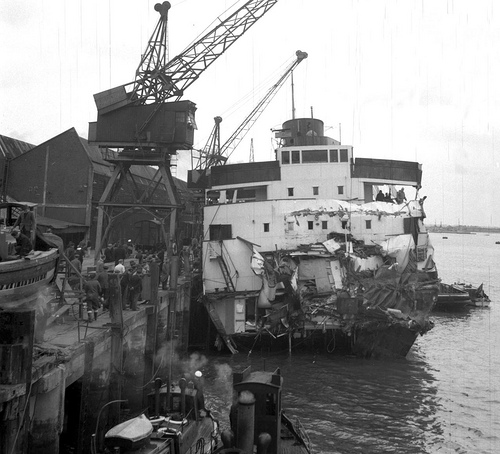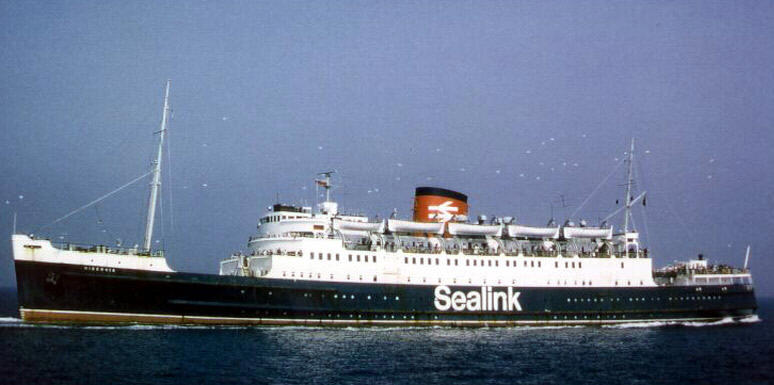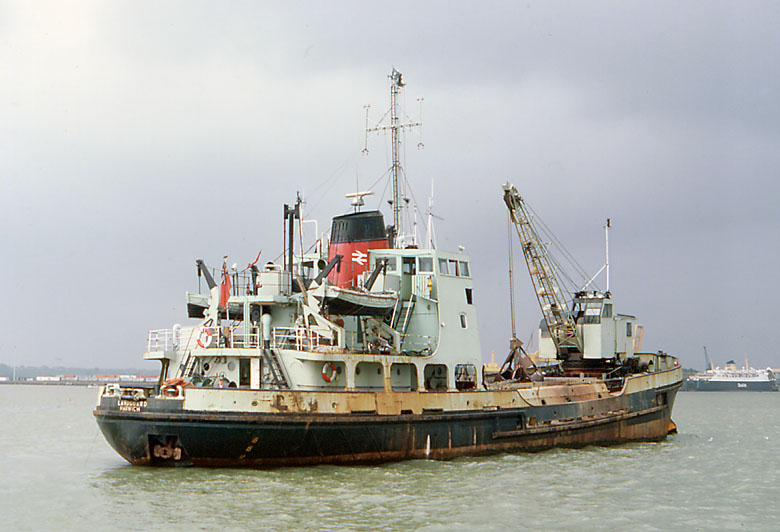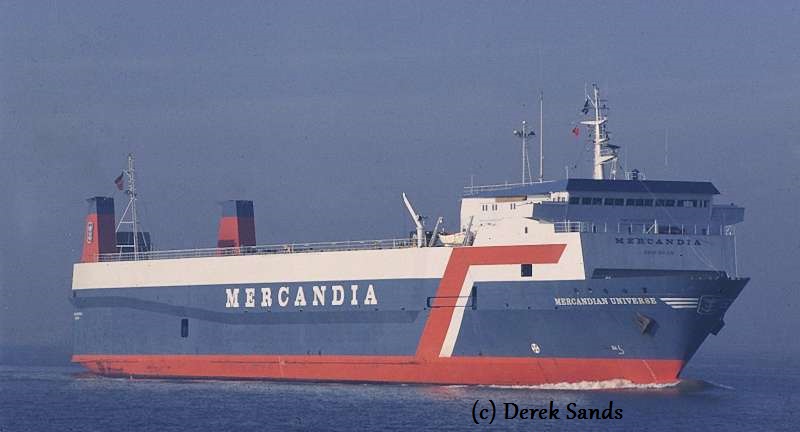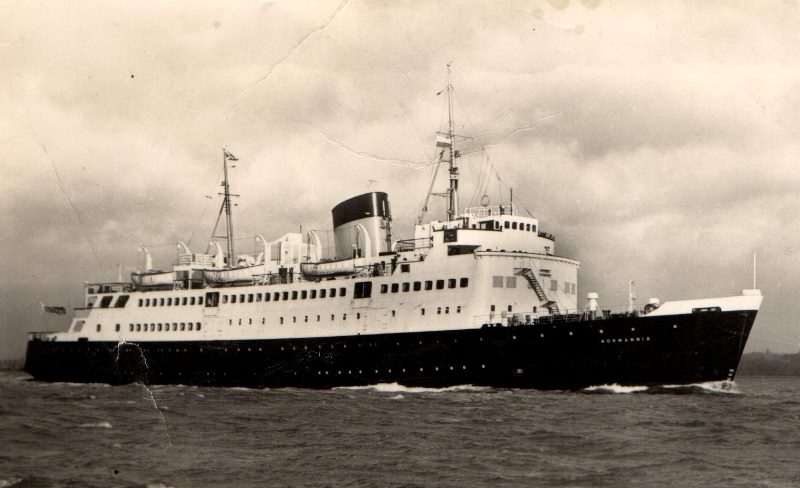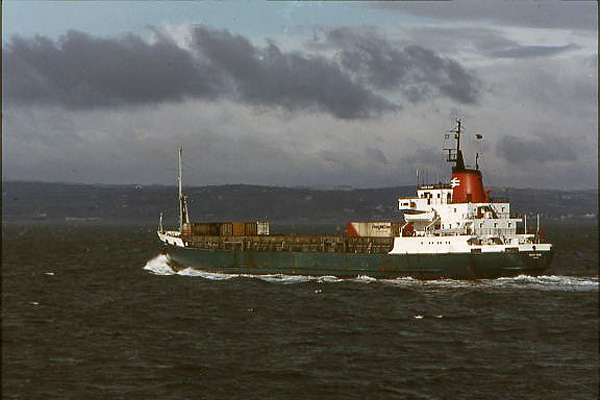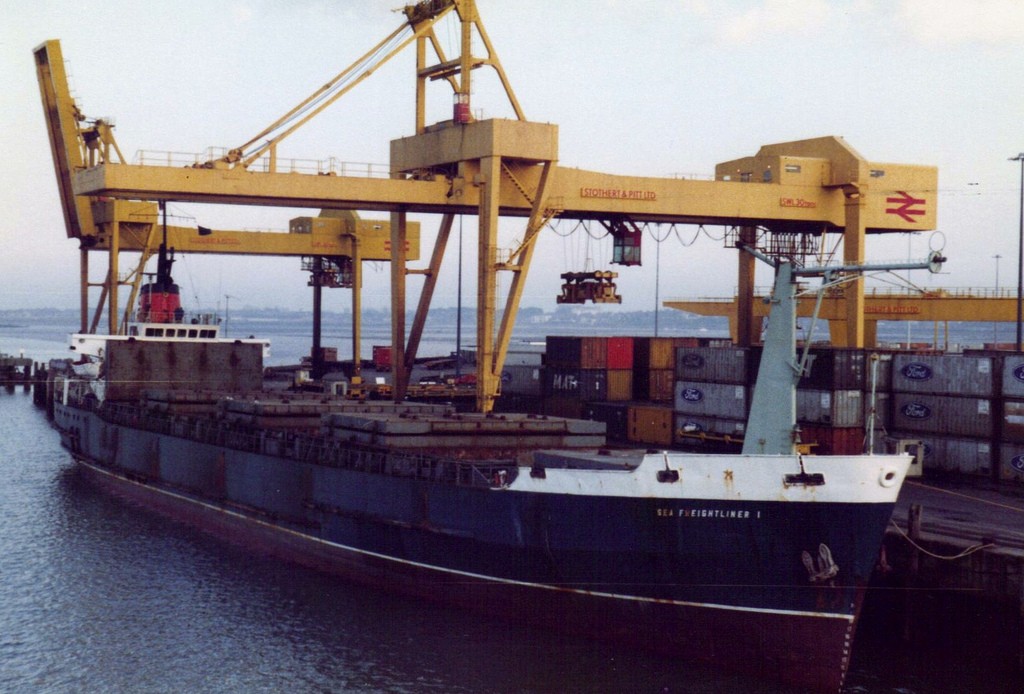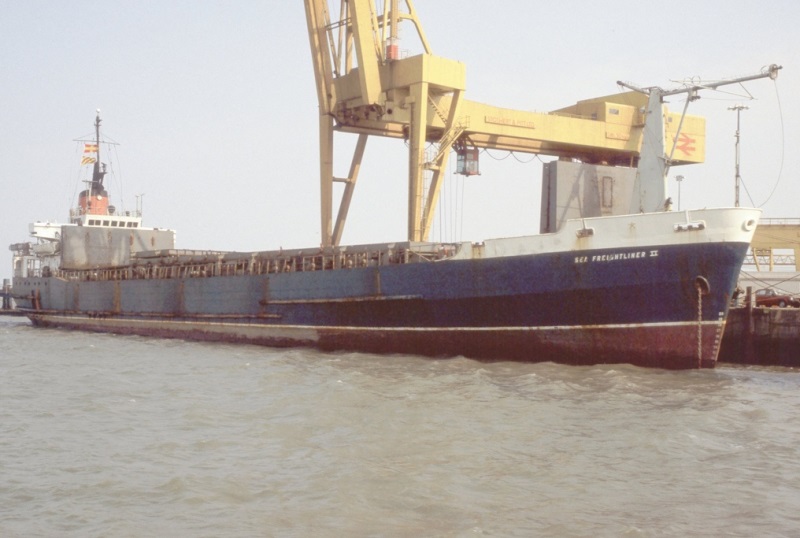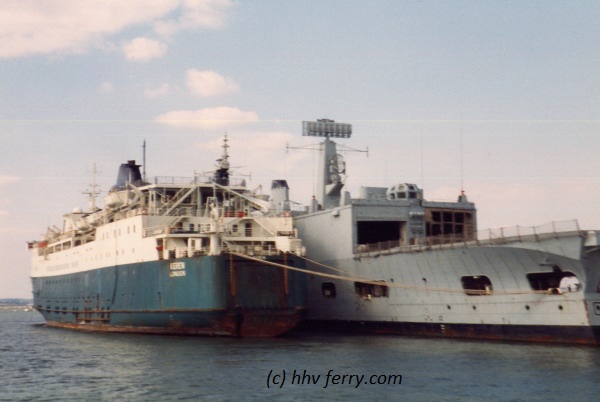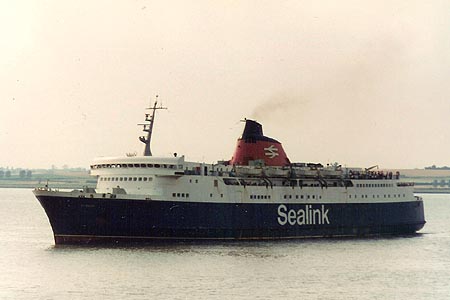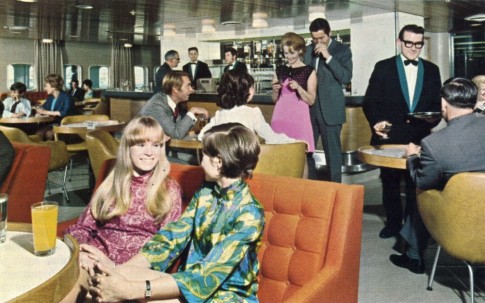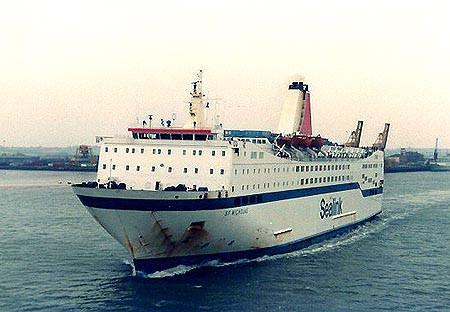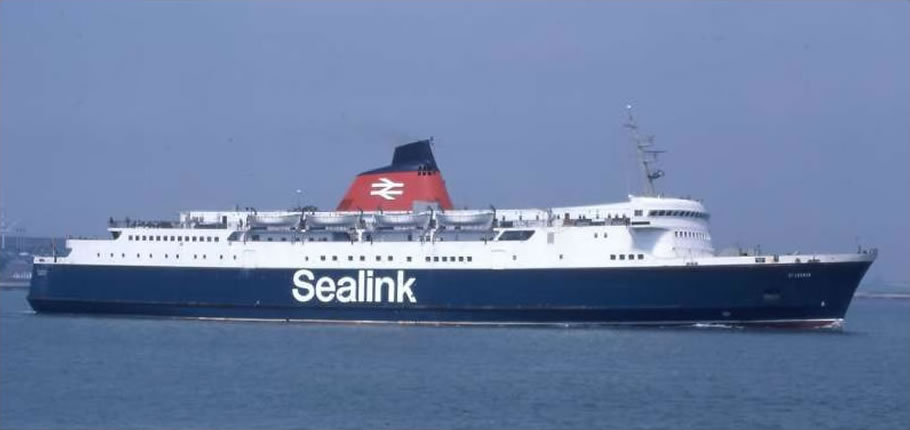
British Rail/Sealink
British Railways operated a number of ships from its formation in 1948 on a variety of routes. Many ships were acquired on nationalisation, and others were built for operation by British Railways or its later subsidiary, Sealink.
British Railways which was formed in 1948 with the ships from former LMS, LNER, SR and GWR fleets. British Railways was rebranded British Rail in 1965, and new corporate colours and logo were introduced.
In 1968 an Act of Parliament separated the shipping interests of British Rail into a new division, for which the marketing name Sealink was adopted in 1970. In 1979, the ownership of vessels was transferred to Sealink UK Ltd, in preparation for the privatisation of the railway fleet. On 27 July 1984 the UK Government sold Sealink UK Ltd to Bermuda-based Sea Containers for £66m. The company was renamed Sealink British Ferries. 7 years later, In 1991 Sea Containers sold Sealink British Ferries to Stena Line. The new Swedish owners changed the company name to Sealink Stena Line then again a few years later to Stena Sealink Line.
In 1996 the Sealink name disappeared when the UK services were re-branded as Stena Line.
Amorique
- Built. 1972 (IMO 7108203)
- Yard. STX Europe, Helsinki
- Class of Ship. Passenger
- Operator. Brittany Ferries/ Sealink
- Route. Harwich – Hook of Holland
- Length. 168m
- Passengers. 1500
- Freight Capacity.470 Cars, 65 freight vehicles
- Speed. 25 knots
- Former Name. Terje Vigen
- Status. Sunk 2011
Mv Amorique was briefly used on the Hook of Holland-Harwich service following the final voyage of Zeeland from Harwich on 25th March 1986. Originally constructed in 1972 for Baltic Sea service as Terje Vigen. She was acquired by Brittany Ferries four years later for their new Portsmouth/St. Malo crossing. She went on to launch the Plymouth/Santander service in 1981 and subsequently the company’s link between Cork in Ireland and Roscoff.
In 1993 she was sold to Xiamen Ocean Shipping Company and getting renamed Min Nam and entering service between Xiamen and Hong Kong in 1994, she was sold again in 1998 to WeiHai ferry co and renamed Sheng Sheng an the being sold to Dharma Lautan and being renamed Tirta Kencana I and then the Musthika Kencana II in 2010. It is believed she sank in the Java Sea in 2011.
Arnhem
-
- Built. 1946 (IMO 1182197)
- Yard. John Brown, Clydebank.
- Class of Ship. Passenger
- Operator. British Rail
- Route. Harwich -Hook of Holland
- Length. 377 ft.
- Passengers. 675
- Speed. 21 knots
- Status. Scrapped 1969
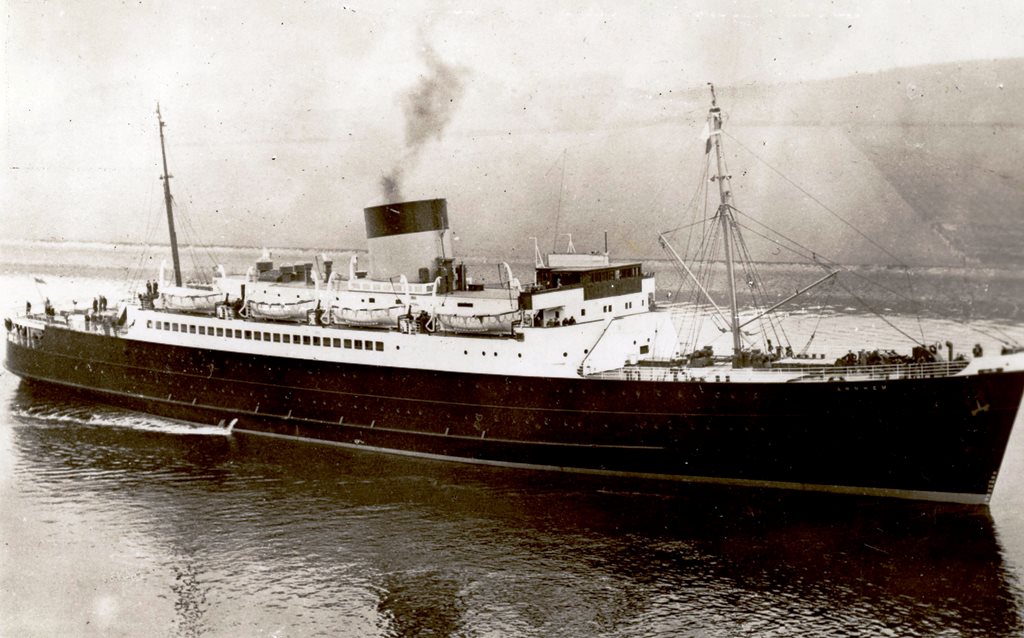
Arnhem
Arnhem was built by John Brown on Clydebank and launched on 7 November 1946. She was the first in a series of ships to replace war losses and was the first oil-fired ship ordered by the company. She had capacity for 600 passengers, and 50,000 cubic feet (1,400 m3) of grain.
In March 1953 she rescued 29 men from the Swedish ship Rigel (3,823 tons) which sank after a collision with an Italian vessel Senegal (1,650 tons) some 60 miles from Ostend.
Initially she was a single class vessel but was converted for first and second classes in 1954.
She was taken over by the British Railways in 1948.
She was scrapped in 1968 by Thos W Ward at Inverkeithing.
Amsterdam (II)
- Built. 1930 (IMO 1161037)
- Yard. John Brown
- Class of Ship. Twin Screw Steamer
- Operator. British Rail
- Route. Harwich – Hook of Holland
- Length. 350 ft.
- Gross Tonnage. 4,225
- Passengers. 548
- Speed. 21 knots
- Status. Mined 1944
Amsterdam was the first of the trio to make courtesy calls to Amsterdam on 12-13th July and Rotterdam on 13th-14th July before making her maiden voyage from Harwich on Monday 15th July 1929. The third of the sisters, the Amsterdam, worked her maiden voyage on Saturday 26th April 1930.
The Amsterdam was requisitioned by the Royal Navy and in use as trooper. This ship was the last merchant ship that left Le Havre, before the enemy blew up the town. In June 1944 the Amsterdam was rebuilt as a hospital ship. On 7th August 1944 mined on the second trip as hospital ship near the French Coast with heavy loss of life.
Amsterdam (III)
- Built. 1950
- IMO. 5015440
- Yard. John Brown
- Class of Ship. Motor ship
- Operator. British Rail
- Route. Harwich- Hook of Holland
- Length. 360 ft.
- Gross Tonnage.
- Passengers. 675
- Speed. 21 knots
- Status. Sank 1987
May 29th 1950. With sirens hooting a welcome from ships large and small in Harwich harbour and at Parkeston Quay the new British Railway’s vessel Amsterdam sailed majestically into Harwich harbour on Monday morning, her new paint glistening in the sun. She had been taken over on the Clyde by the Marine Superintendent, Capt. R. Davis, after very successful trials. A big crowd saw the ship pass through the harbour with her siren sounding.
The last word in comfort for passengers and crew, the new ship was is equipped with every modern aid to navigation and control. For the passengers there is attention to detail in cabin furnishing and deck, companion way and saloon spaciousness, which will make the overnight crossing a luxury on its own.
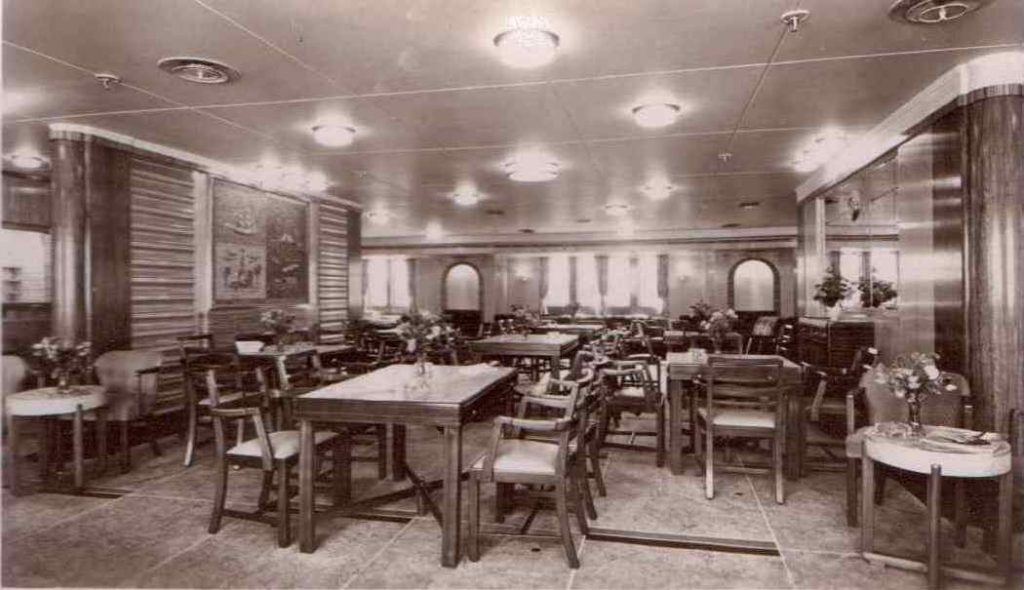
Amsterdam III
The final touch which lifts the ship clear of any austerity is to be found in four “cabins de-luxe”, each with two beds and a bathroom, and each decorated in a distinctive colour-scheme – red; pink and silver; blue and white; and green and brown.
The crew. as well as finding the ship “easy-working” , due to her spaciousness and the convenience of well-thought out fittings, are pleased with their own quarters, Ventilation and crew’s quarters are a great improvement on those in other ships on the Harwich-Hook service.
Proposing good fortune to the Amsterdam, Captain P.D.H.R. Pelly, D.S.O.,R.N., senior officer, Reserve fleet, Harwich, said it was appropriate the he, as a naval officer, should have had the honour. Merchant ships were an essential part of our life in peace and war, and the task of protecting them was undertaken by the Navy. He wished success to the Amsterdam and all who sailed in her.
Sold in 1969 to Chandris Line, converted to a cruise ship and renamed Fiorita. Laid up in 1978 and used from 1978–80 as an accommodation ship. Renamed Ariane II in 1980 and laid up until 1983. Served as an accommodation ship at Fethaye, Turkey until she capsized and sank in a storm on 27 January 1987.
Anni Liebisch
- Built. 1950
- IMO. 5019161
- Yard. Holst Schiffswerft
- Class of Ship. Cargo
- Operator. British Rail (Charter)
- Route. Harwich-Antwerp 1963
- Length.
- Gross Tonnage. 299
- Speed.
- Status. Scrapped 1995
- German Freighter arrived at Parkeston Quay 19-10-1963.
- Anni Liebisch (1962) – Cap Arkona (1966) – Venetiko (1970) – Aghios Nicolaos (1970)
- Ermioni (1974) – Gorgona (1973) – Abdul Bassed (1976) – Marwan M (1978).
Avalon (III)
- Built. 1963
- IMO. 5418915
- Yard. Alexander Stephen & Sons
- Class of Ship. Twin screw motor ship
- Operator. British Rail
- Route. Harwich – Hook of Holland
- Length. 404 ft.
- Gross Tonnage. 6584
- Passengers. 750
- Speed. 21.5 knots
- Status. Scrapped 1981
-
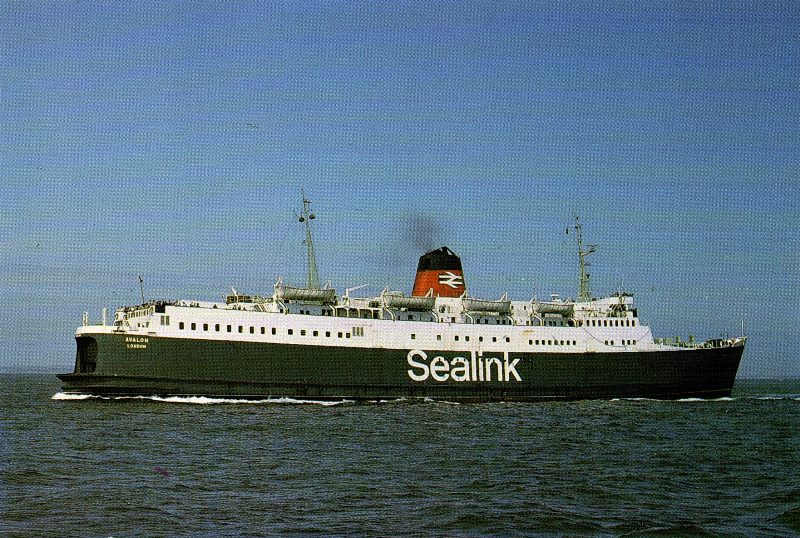
Avalon III
After performing trials in the Clyde Avalon steamed to Harwich to undergo berthing trials and made her first sailing on 25th July 1963. Probably the quietest arrival of a new ship in her home port. There was no excitement about this arrival of a brand new ship. The naming ceremony did not take place in Scotland owing to labour troubles at the shipyard. Apart from the Avalon giving a “How d’you do” toot as she nosed slowly across the harbour towards the quay, the sound from ships’ sirens was noticeably absent.
The Avalon was brought alongside the quay with calculated precision . There were no cheery waves from the quay to the ship or from the ship to the quay. It was a really quiet affair.
On the quayside, Mr T. Tulloch, the shipping port superintendent, waited with a group of officials and dock staff. The gangway was put into position-and the ship was in.
Captain Frederick Allen
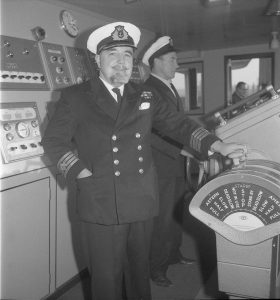
Captain Allen
A familiar figure to thousands of passengers on night ships between Parkeston Quay and Hook of Holland, he left the bridge of ss Avalon for the last time in his official capacity. Before he joined the London and North Eastern Railway in 1934, Captain Allen had been a “deep sea” man. His first voyage from Liverpool at the age of 16 was to Australia and this began the thousands of sea travel by sail and steam which has now drawn to a close. For a time he served with the train ferries between Harwich and Zeebrugge until events of the Second World War halted the service. Then came Dunkirk when, with many of is Harwich colleagues, Captain Allen was aboard the railway ships that played such an admirable part in the evacuation of the British Expeditionary Forces.
U-boat battle
Later, in view of his experience of Belgian waters, Captain Allen acted as the first commander-in-chief of the Free Belgian Navy. Then, with the Royal Navy Reserve, he served in the anti-submarine patrols that turned the tide against the menace of the U-boats.
After the war, Captain Allen returned to the Harwich ships and later, in 1953 he made his first trip as master of the passenger ship Duke of York. He took command of the Avalon in 1964.
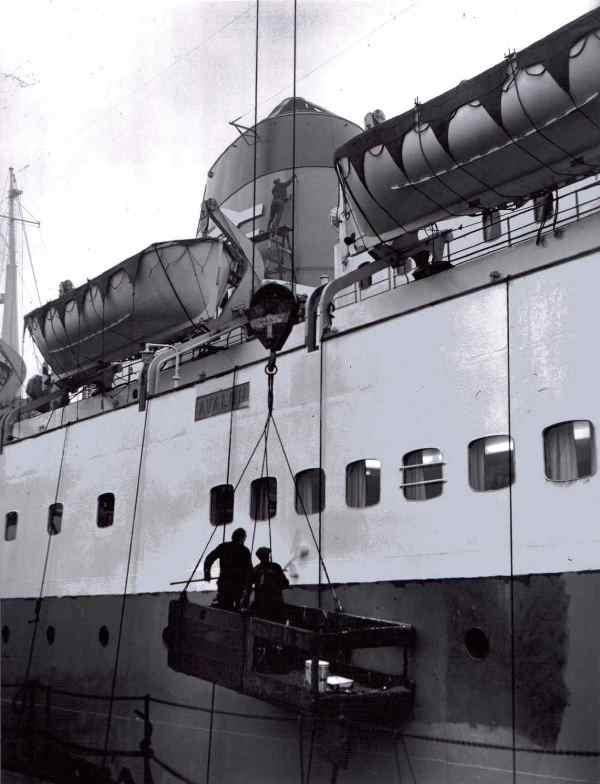
Avalon
In 1974, with Sealink’s need for additional car-carrying capacity Avalon was dispatched to Swan Hunters on the Tyne for the conversion, resulting in her two lower decks being gutted of cabins to house two car decks. Thus, ended her cruising career. On 24th September 1980, after six years’ service in the Irish Sea on the Fishguard-Rosslare and Holyhead-Dun Laoghaire routes, she was laid up in Barrow, for sale, at the relatively young age of 17 years. Three months later, in December, she was sold to Cypriot-based Seafaith Navigation Co and, crudely renamed “Valon”, re-sold to Pakistan breakers HH Steel Limited, arriving at Gadani Beach on 22nd January 1981 to be dismantled.
Brathay Fisher
- Built. 1971
- IMO 7103033
- Yard. Van Der Werf, Deest
- Class of Ship. Cargo
- Operator. James Fisher (British Rail-Charter)
- Route. Harwich – Zeebrugge/Rotterdam
- Length. 105.9
- Gross Tonnage. 3604
- Speed. 14.5 knots
- Status. Scrapped 27/06/2003
Seen approaching Parkeston Quay,whilst on charter to British Rail for the Harwich-Dunkirk “Freightliner” service. Chartered from 1971 by British Rail for the Parkeston Quay – Dunkirk service and in 1974-1975 for the Harwich-Dunkirk service. from 1978-1980 charterd back to assist on the Harwich- Zeebrugge/Dunkirk service.
Calderon (1976) – Brathay Fisher (1978) – Haje Naime (1981) – Violette (1983) -Haje Naime (1983) – Newpoint (1985) – Pel Carrier (1985) – Pancon 3 (1994) -Progress 3 (2002)
Brian Boroime
- Built. 1970 (IMO. 7015327)
- Yard. Verolme Dockyard, Cork.
- Class of Ship. Container
- Operator. British Rail
- Route. Harwich-Zeebrugge/Rotterdam
- Length. 351.9
- Gross Tonnage. 4098
- Speed. 14.5 knots
- Status. Scrapped 17/4/2012
Used a relief ship for the Sea Freightliners at Parkeston Quay from 13h October 1970 – 5th December 1970.
Pelttainer (1990) – Abdul H. (2004).
Colchester II
- Built. 1957
- IMO. 5076987
- Yard. Goole Shipbuilding
- Class of Ship. Container/Cargo
- Operator. British Rail
- Route. Harwich- Dunkirk/Rotterdam 1959-1972
- Length. 241.8
- Gross Tonnage. 866
- Speed. 13.5 Knots
- Status. Scrapped 2011
Served on routes between Harwich –Rotterdam & Dunkirk from 1959 -1972.
Taurus II (1975) – Gloriana (1979) – Sea Wave (1984) – Taurus (1985) – Diana (1991).
Derwent Fisher
- Built. 1966
- IMO. 6602018
- Yard. Nieuw Noord Nederlandsche
- Class of Ship. Cargo Ship
- Operator. James Fisher & Sons (BR Charter)
- Route. Harwich – Antwerp
- Length. 66.1m
- Gross Tonnage. 1096
- Speed.
- Status. Scrapped 15/04/2002
Parham (1979) – Sofia (1984) – Saint Anthonys (1989) – Golden Bird (1990) Mariya (1991) Swene (1996) – Baris B. (1996)
Launched by James Fisher & Sons, Barrow and Chartered by British Rail in 1968 for service between Parkeston Quay and Antwerp.
Duke of York
- Built. 1935 (IMO 5423099)
- Yard. Harland & Wolff
- Class of Ship. Passenger
- Operator. British Railways
- Route. Harwich –Hook of Holland 1952-1964
- Length. 339 ft.
- Gross Tonnage. 3,743
- Passengers. 379
- Speed. 21 Knots
- Status. Scrapped 1976
Built at Harland and Wolff, Belfast and completed in 1935, Duke of York was designed to operate as a passenger ferry on the Heysham to Belfast route.
The Duke of York was requisitioned in 1942 for war service. She was renamed HMS Duke of Wellington. The conversions allowed her to carry 250 troops and ten Landing Craft Assault to carry them to shore. For anti-aircraft defence a 12 pounder gun and eight 20 mm cannon were fitted.
She reverted to her original name after the war, and in May 1948 she was transferred to the Harwich to Hook of Holland service, alongside the Arnhem.
Originally a twin funnel vessel, she was rebuilt in 1950 with a single funnel. She was upgraded from coal to oil firing and cabin accommodation for 520 passengers was provided.
On 6 May 1953, she collided in fog with the American freighter USNS Haiti Victory. Six passengers were killed and the bow was completely sheared off just in front of the bridge. Duke of York arrived back at Parkeston Quay shortly before midnight. She was moored to buoys in the river before being taken alongside some eight hours later. Six bodies were recovered, one passenger remained unaccounted for and eight passengers were injured. She was re-built by Palmers Shipbuilding and Iron Company of Jarrow-on-Tyne with a more modern shaped bow and lengthened by about 7 ft. She re-joined the Harwich fleet in 1954.
Last sailing.
A Familiar site for many years the 28 year old steamer left Harwich on Sunday 8th September 1963 for the last time. now named York, of Monrovia, the vessel was sold by British Railways to a Greek firm for Mediterranean cruises. She left Harwich at 6 a.m. for North Shields for conversion work before setting off for her journey into the sun.
She entered service in 1964 as the Fantasia. She was withdrawn in December 1975 and was broken up in 1976 in Spain.
Hibernia
- Built. 1948 (IMO 5150111)
- Yard. Harland & Wolff
- Class of Ship. Passenger
- Operator. British Rail 1948-1976
- Route. Harwich –Hook of Holland 1968
- Length. 121.0
- Gross Tonnage. 4972
- Passengers. 2361
- Speed.
- Status. Scrapped 18/12/1980
Built for services between Holyhead and Dun Laoghaire, Hibernia was used as a relief ship in 1968 and made two round trips on the Harwich-Hook of Holland day service.
She was sold in 1976 to the Agapitos Brothers in Greece and became the Express Apollon but never traded in Greece. She remained laid-up at Salamina, and was sold to Indian breakers in 1980. She arrived in Darukhana, India in 1980 for scrapping by Ankom Solid Steel Traders, and had been demolished by 1981.
Landguard II
- Built. 1959
- IMO. 5203140
- Yard. Goole Shipbuilding
- Class of Ship. Grab Dredger
- Operator. British Rail/Sealink
- Length. 48.2
- Gross Tonnage. 674
- SWT. 737
- Power Output: 382 kw
- Status. Scrapped 03/07/1989
Built in 1960 for the British Transport Commission by Goole Shipbuilding Co Ltd, the Landguard spent almost her entire career on the River Stour form 1960 – 1990 before being broken up at Gillingham in July 1989.
Captain Owen May was on the old dredger, Landguard as a mate, The difference between the two vessels is like that between chalk and cheese, Whereas the old Landguard was not much more than a barge, the new vessel had the comfort of a modern home, with the latest navigational devices.
Mercandian Universe
- Built. 1986 (IMO 8400036)
- Yard. Frederikshavns Vaerft
- Class of Ship. Cargo
- Operator. Sealink (Charter)
- Route. Harwich – Hook of Holland 1989
- Length. 160.5 m
- Gross Tonnage. 15375
- Speed. 15 knots
- Status. Sailing
Chartered by Sealink British Ferries in January 1989 on the Harwich-Hook of Holland route.
Seaboard Universe (1992) – Crowley Universe (1999) – Maestro Universe (2008)
Normannia
- Built. 1952
- (IMO 5256408)
- Yard. William Denny & Brothers
- Class of Ship. Passenger
- Operator. Southern Region
- Route. Harwich –Hook of Holland
- Length. 309 ft.
- Passengers. 1400
- Freight Capacity. 12 Cars
- Speed. 19 knots
- Status. Scrapped 06/12/1978
Although not a regular Harwich ship, the ‘Normannia’ played a significant but brief part in Parkeston Quay’s history in 1953 and 1954 when, following ‘Duke of York’ being sliced in two by the ‘USNS Haiti Victory’ in May 1953 and being dispatched to Palmers Shipbuilding’s yards at Jarrow-on-Tyne, she stood in for the ‘Duke’ on the Harwich-Hook services.
The ‘Normannia’ was built at the renowned shipyards of William Denny & Bros., at Dumbarton on the River Clyde, 22 miles from Glasgow, and launched on 15th July 1951 for the account of the then British Transport Commission – Southern Region, for their services between Southampton and Le Havre. As built, she was a classic (pre-RoRo) ferry with impressive wood-panelled public spaces plus equally impressive wood-panelled cabins for her overnight crossings. Equipped with the builders’ powerful steam turbines, on sea trials she reputedly achieved the commendable speed of 20.62 knots.
In 1963, ‘Normannia’s ownership transferred from the British Transport Commission to the newly created British Railways Board and, on 3rd December 1963, the ‘Normannia’ arrived back at Southampton on her last crossing from Le Havre. Sadly, due to the advancing RoRo era, the classic ferry was dispatched to the Hawthorn Leslie’s shipyard on the Tyne and converted to a stern loading/unloading Ro-Ro.
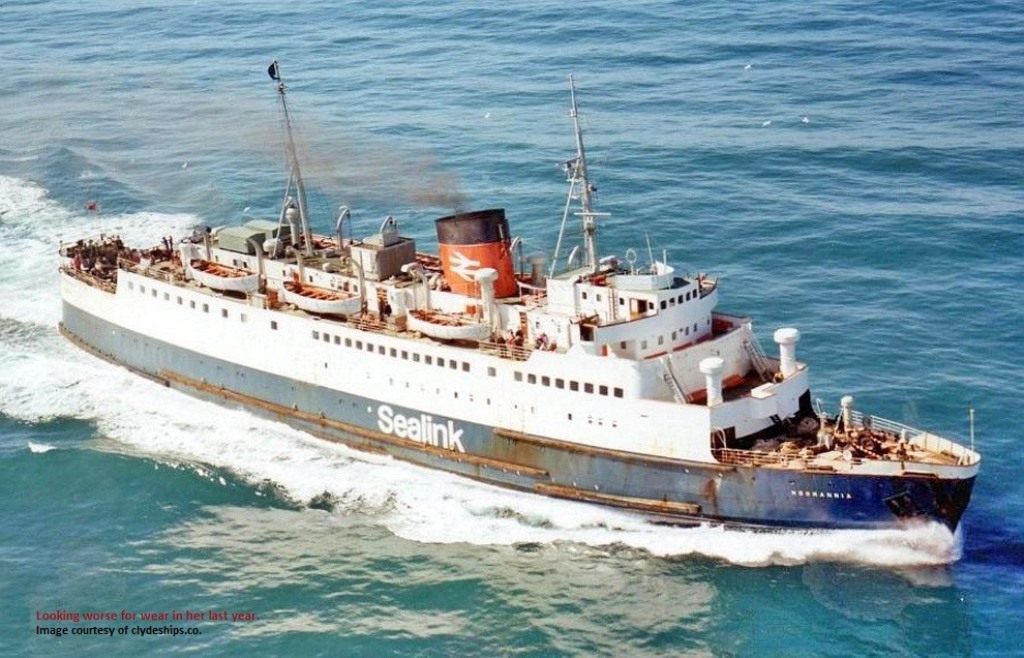
Normannia
The ‘Normannia’ re-emerged in April 1964 with a load capacity for a maximum 111 cars and a reduced passenger capacity of just 500 and was initially placed into service between Dover and Boulogne. On 9th July 1965, she inaugurated British Rail’s car ferry services between Holyhead and Dun Laoghaire pending the late arrival of the new ferry from her builder, whereupon, ten days’ later, on 19th July she returned to the English Channel. Unusually, for two summers in 1968 and 1973, ownership was temporarily changed to Soc. Nationale des Chemins de Fer (SNCF) for their service between Calais and Dover. Equally unusual, in June 1972, the ‘Normannia’ was chartered to British Rail’s competitor Townsend Car Ferries Ltd. for their summer season services between Dover and Zeebrugge.
In 1975, the ‘Normannia’ transferred to Weymouth and operated the summer season services to the Channel Islands and Cherbourg, returning to Dover in 1977 until January 1978. This was reportedly followed by three to four months relief duties at Weymouth until, in May 1978, she was withdrawn from service and laid up for sale. Not long after being laid up, she was reported sold to Dubai-based Red Sea Ferries Ltd. but, for whatever reason, this deal fell through. After 7 months laid up, the once-classic ‘Normannia’ was sold to Spanish ship breakers Desguaces Heme SA and, on 6th December 1978, she arrived at Gijon to be scrapped.
Rhodri Mawr
- Built. 1970
- IMO. 7019220
- Yard. Verolme, Cork.
- Class of Ship. Container
- Operator. British Rail/Sealink
- Route: Harwich-Zeebrugge 1973
- Length. 107.1
- Gross Tonnage. 4095
- Speed. 14.5 knots
- Status. Scrapped 19/11/2014
During 1969 S.N.C.F opened a new ro-ro service from Dunkirk – Parkeston Quay the service was initially thrice-weekly, later becoming five times a week arriving Parkeston Quay 2300 and sailing at 0500.
Peliner (1990) – Destiny (2004) – Yamm (2010).
Broken Up Aliaga 19.11.2014
Seafreightliner I
- Built. 1968
- IMO. 6803416
- Yard. Readhead & Sons, South Tyneside
- Class of Ship. Container
- Operator. British Rail/Sealink
- Route: Harwich-Zeebrugge
- Length. 118.3
- Gross Tonnage. 4043
- Speed. 13.5 knots
- Status. Scrapped 11/05/1987
These two container ships operated the service between Harwich and Zeebrugge and were the first of their type to be built in Britain. The containers slotted into cell spaces in sectioned holds, occupying the whole of the cargo space. Each ship made one round trip per day, both built in south shields they entered service in 1968. After a period of lay up she sailed to Falmouth in 1987 and then on to Naples and China via Colombo. SFL I was scrapped in Kaohsiung in May 1987.
Seafreightliner II
- Built. 1968
- IMO. 6812352
- Yard. Readhead & Sons, South Tyneside
- Class of Ship. Container
- Operator. British Rail/Sealink
- Route: Harwich-Zeebrugge
- Length. 118.3
- Gross Tonnage. 4034
- Speed. 13.5 knots
- Status. Scrapped 17/01/1987
These two container ships operated the service between Harwich and Zeebrugge and were the first of their type to be built in Britain. The containers slotted into cell spaces in sectioned holds, occupying the whole of the cargo space. Each ship made one round trip per day, both built in south shields they entered service in 1968. After a period of lay up she left the River Blackwater on 26th September 1986 for Tilbury and then to Naples and Pakistan loaded with scrap pipe. Arrived at Karachi on 2 January 1987 and was beached for scrapping.
St. Edmund
- Built. 1973 (IMO 7340710)
- Yard. Cammell Laird Shipbuilders Ltd
- Class of Ship. Twin screw motor ship
- Operator. British Rail/Sealink
- Route. Harwich – Hook of Holland
- Length. 119.51 m
- Gross Tonnage. 8987
- Passengers. 1400
- Berths. 671
- Speed. 21 knots
- Status. Scrapped 2009
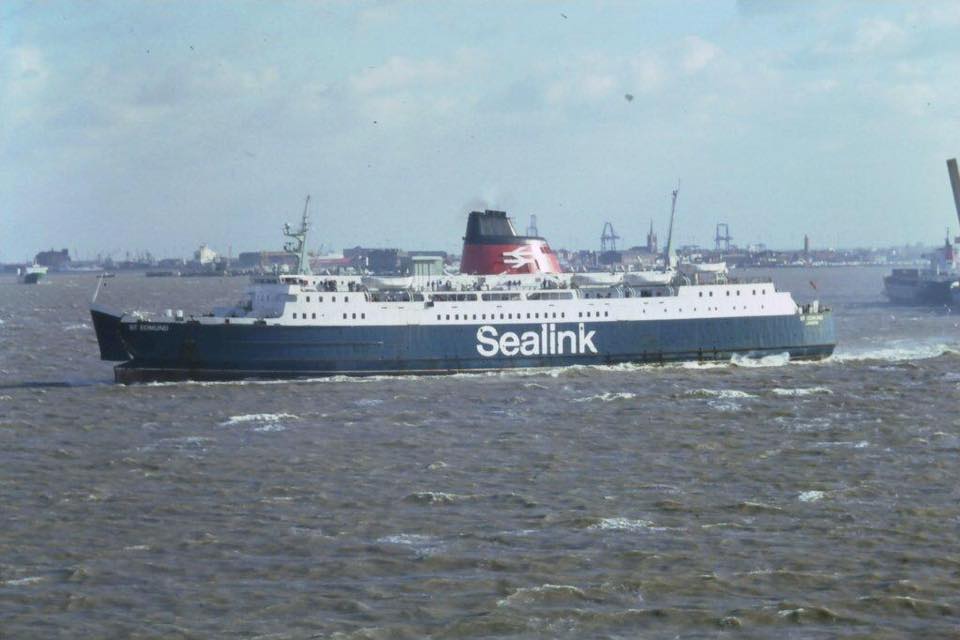
St Edmund
St Edmund was launched on the 14th November 1973 and entered service on the 19th January 1975,the new car ferry service proved to be very successful and by 1970 traffic had reached sufficient levels to warrant the building of a third vessel for the route. The contract for the new and larger ship was given to Cammell Laird at Birkenhead. The new St. Edmund was launched on 13th November 1973 but due to long delay’s she entered service on 19th January 1975. The St. Edmund was a vast improvement on the St. George and boasted accommodation for as many as 1400 day passengers, 1000 night passengers and 300 cars. On her entry into service the new ship took over the main sailings while the St. George was used as back-up at peak periods. In spring 1982 the St. Edmund was requisitioned by the Ministry of Defense for the Falklands war.
- She entered service for Sealink between Harwich and the Hook of Holland in January 1975. In 1982 St Edmund was requisitioned for use as a troop transport in the Falklands campaign. February 1983 the ship returned to the UK but was promptly purchased by the Ministry of Defence for more service in the South Atlantic as HMS Keren. This work lasted more than two years, but in July 1985 she returned to the UK and was laid up near Portsmouth for sale.
- Subsequently purchased by Cenargo, she adopted the name Scirocco and was made available for charter work – including periods with Tirennia, Trasmed, Comanav and Cotunav. A longer-term charter opportunity arose in early 1989 and the ship was despatched back to UK waters to become the Rozel, new flagship of British Channel Island Ferries, replacing their pioneer ship Corbiere. This charter lasted for three years until early 1992 but BCIF were unable to agree terms for a further extension, and the ship was returned to her owners, resuming the name Scirocco. Subsequent charter work with Comanav and Cotunav again followed, but the former St Edmund finally settled down on her owners Ferrimaroc service between Nador and Almeria. This work lasted until early 2004 when she was sold to the Egyptian El Salem organisation. However she was chartered back for Summer 2004 to work for her former charterers Comanav as the Santa Catherine I where she served their Nador-Almeria route in direct competition with her previous operators.
St. George (II)
- Built. 1968
- IMO. 6810897
- Yard. John Brown & Co. Ltd., Clydebank
- Class of Ship. Twin screw motor ship
- Operator. British Rail/Sealink
- Route. Harwich – Hook of Holland 1968-1983
- Length. 115.22 m
- Gross Tonnage. 7356
- Passengers. 1200
- Freight Capacity. 200 Cars
- Speed. 21 knots
- Status. Scrapped 2008
The “St George” was built by Swan Hunter & Wigham Richardson at Wallend-on-Tyne and launched 28th February 1968, representing a significant achievement by her naval architects Tony Rogan and Don Ripley (of British Rail) and her interior designers Ward & Austin. Designed to serve both night crossings and day crossings between Harwich and the Hook of Holland (although when she entered service on 17th July 1968, she operated only night sailings due to delays to the arrival of her Dutch counterpart) she was provided with superior First Class and Second Class facilities for 1,200 day passengers, with night crossing accommodation usually limited to between 700 and 750 passengers, with cabin berths for 550 and reclining seats for 100. As remarked upon in her introductory brochure, “De Luxe cabins were located amidships on A Deck, the lower of the main passenger decks. Beneath the vehicle deck (C Deck) were crew and some Second-Class cabins whilst along the sides at mezzanine level (B Deck) were First Class cabins (aft) and Second Class (forward) with some interchangeable rooms in between. Some of the four-berth outside Second Class cabins at this level were convertible to six-person day cabins.” To meet the changing needs for the Harwich-Hook route, “St George” was fitted with four powerful 9-cylinder diesels built by Ruston & Hornsby, Lincoln, giving her a speed (on sea trials) of 22 knots.
- Sadly, after just 15 years on the Harwich-Hook route, she was withdrawn from service on 6th June 1983, remaining idle at Harwich until relocated to Immingham on 20th September for machinery repairs. Subsequently, on 10th November 1983, she was laid up in the River Fal – a reported sale to Folkline having fallen through. There had also been plans to introduce her onto a new service between Poole and Bilbao under the brand name British Iberian Lines, with the intention to rename her “Maiden Castle” (after the historic Iron Age hillforts in Dorset) but this, unfortunately, did not transpire. On 18th September 1984, the “St George” was purchased by the Cypriot, Limassol-based Psatha Navigation Co., Ltd., renamed “Patra Express” and was operated by Piraeus-based parent company Ventouris Ferries between Greece and Italy, although registered ownership (as opposed to beneficial ownership) changed twice: in 1988 to the Honduras registered (brass blaque) company Gitank Shipping Co., and in 1989 to Patra Express Shipping Co. Noteworthy, also, is that in 1988, she had her (by then 20 years old) Ruston diesels replaced.
In 1990, the “Patra Express” ex “St George” was purchased by Nassau-based Marine Investment Limited, an offshore subsidiary of the Danish ferry company DFDS (Det Forenede Dampskibs-Selskab) and sent, via Hull, to Humber Shiprepairs Limited at Immingham and, between April and July 1990, renamed “Scandinavian Sky II”, was refitted and refurbished for short cruises. In July 1990, registered ownership (as opposed to beneficial ownership) was changed to the Bahamas-registered company MSJ Shipping Limited, renamed “Scandinavian Dawn” and placed on the Miami-based SeaEscape Cruises’ cruise operation between Fort Lauderdale and Freeport, Bahamas. However, a year later, in 1991, (a year after the devastating fire aboard “Scandinavian Star” which killed 159 souls) SeaEscape Cruises declared themselves bankrupt but, filed under Chapter 11, the U.S Bankruptcy Court in Miami granted the company time to restructure their operations – which they did, chartering out or selling most of their ships, leaving “Scandinavian Dawn” continuing to operate.
In 1996, Miami-based ‘New SeaEscape’ acquired the assets of its predecessor, including “Scandinavian Dawn”, which was renamed “Discovery Dawn”, maintaining the day-cruise operations to Freeport for two more years. In May 1998, the company reputedly applied for a license to operate her out of New York on gambling cruises, but the application was refused and the ship was laid up – but not for long, re-emerging as “Island Dawn” on the Bahamas day-cruises for another year. In late-1999 “Island Dawn” ownership changed to Nassau-based Discovery Dawn Ltd (Partnership) Inc. and she was reputedly trialled on casino gambling cruises off limits out of Port Isabel, Texas, but this was unsuccessful.
A year later in July 2000, renamed “Texas Treasure”, she was chartered to Viva Gaming & Resorts for casino cruises, initially from Corpus Christi, Texas, sailing twice daily (once during the day, once at night) six days a week from Port Aransas, then (between October 2002 and March 2003) from Palm Beach, Florida, subsequently from Port Aransas, Texas again, before both owner and charterer ceased trading due to debts, resulting in the ship being arrested in the Bahamas in May 2008. During these eight years, registered ownership frequently changed to reflect the area of operation, and included Corpus Christi Day Cruises Inc., plus Florida Day Cruises Inc.
In July 2008, the 40-year-old former “St George” was sold at auction to Indian shipbreakers. She arrived at Alang on 23rd September and, three days later, on 26th September 2008, was beached for dismantling.
St Nicholas
- Built. 1981
- IMO. 7901772
- Yard. Götaverken Arendal Ab
- Class of Ship. Twin screw motor ship
- Operator. Sealink
- Route. Harwich – Hook of Holland
- Length. 149m
- Passengers. 2100
- Freight Capacity. 480 cars
- Speed. 20.4 Knots
- Former Name. Prinsessan Birgitta
- Status. Scrapped 2012
St.Nicholas made her maiden voyage on 10th June 1983. The new ship boasted two restaurants offering both self-service style and a la carte meals. The St. Nicholas went to Bremerhaven on 7th January 1991 for a refit and emerged as the Stena Normandy. She returned on 21st January 1991 for a brief final spell.
In 1983 she was chartered to Sealink as the St Nicholas, for their Harwich-Hook of Holland service. In 1990, Sealink was acquired by Stena Line Ab. In 1991, St Nicholas was renamed Stena Normandy, in preparation for moving to the Southampton-Cherbourg route later that year. This route closed in 1996. In 1997 she was chartered to Tallink for Tallinn-Helsinki services as the Normandy.
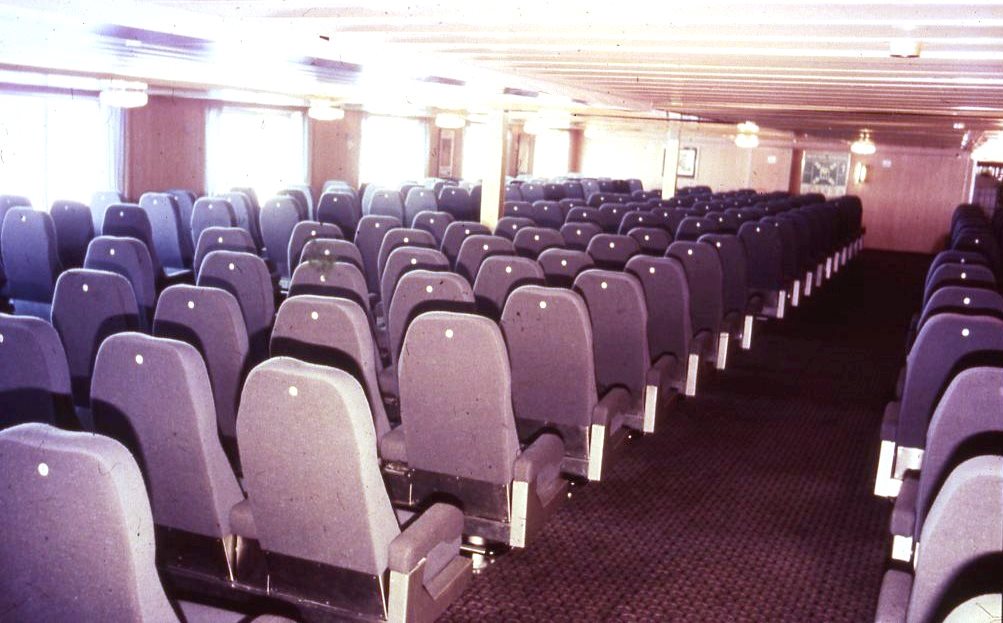
2nd Class Seating
In 1997 she was chartered to Irish Ferries as Normandy for use on their France-Ireland routes. She was purchased by Irish Ferries’ parent company Irish Continental Line in 1999.
On November 5, 2007, the Normandy sailed from Rosslare to Frederica, Denmark, where she was laid up until sold to the Singapore-based oil service company Equinox Offshore Accommodation on 28 January 2008. The new owners planned to rebuild her into an accommodation and repair vessel at SembCorp Marine shipyards, Singapore. However, instead of being rebuilt she was chartered to the Morocco-based Ferrimaroc in March 2008, entering service on the Almeira—Nador route in April 2008. She finally left the Mediterranean in the autumn of 2008 and arrived in Singapore on 19 October for her planned conversion.
The planned conversion of M/S Normandy never happened, and the ship was abandoned by her last owners at a berth in Singapore. After this the condition of the ship declined rapidly with broken windows allowing flooding, mold and plants to take over the interior of the ship.
On 31 October 2012, M/S Normandy left Singapore for India and was scrapped shortly after.
Photo Gallery
Click “Play” to start the gallery slide show.
We are adding more information to this site on a regular basis, if you wish to submit any photos or provide any information, then please use the contact page at the bottom of the screen.
Copyright Ownership.
We attempted to get the consent of copyright holders to use this material for nearly all of the photographs on the website.
In the few cases where names are available, a thorough search was made using telephone directories, photographic copyright directories, People Search and Google Area Search. None of the copyright owners could be traced in this way and we believe we have exhausted all reasonable avenues.
The consensus opinion of these authorities was that if any two of the following situations applied we would be deemed to have taken sufficient action to avoid infringing copyright laws:
- Reasonable efforts made to contact the copyright holder
- No financial gain will be made in relation to the photos
- A letter is obtained from present owner of photos
- There is a proviso included stating that if offence is caused document will be removed
The website owner undertakes to remove any photograph from the website where offence is caused. All the above conditions have therefore been met.
- I wish to thank the following people for their contribution to this project.
- Derek Sands, John Wray, Kevin Hoggett, Peter Robinson,Alan Dumelow
and all those that have allowed me to use their photos.
← DFDS Bell Lines →

